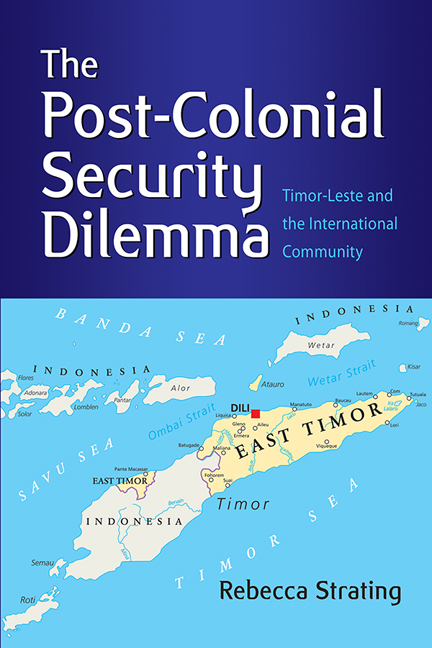Book contents
- Frontmatter
- Contents
- List of Tables
- Acknowledgements
- 1 Introduction
- 2 The Struggle for Recognition: Territorialization, Self-determination and the Imagining of “East Timor”
- 3 The Politics of Recognition: East Timor and the International Community
- 4 Establishing Legitimacy: International State-building in East Timor
- 5 Timor-Leste's Aspirational Foreign Policy
- 6 Identity Hedging: Timor-Leste's Engagement with Intergovernmental Organizations
- 7 Timor-Leste's National Security Agenda
- 8 Securing Economic Sovereignty
- 9 International Reconciliation and Transitional Justice
- 10 Conclusion: Timor-Leste in the Changing Regional Order
- Postscript
- Bibliography
- Index
- About the Author
10 - Conclusion: Timor-Leste in the Changing Regional Order
Published online by Cambridge University Press: 16 May 2019
- Frontmatter
- Contents
- List of Tables
- Acknowledgements
- 1 Introduction
- 2 The Struggle for Recognition: Territorialization, Self-determination and the Imagining of “East Timor”
- 3 The Politics of Recognition: East Timor and the International Community
- 4 Establishing Legitimacy: International State-building in East Timor
- 5 Timor-Leste's Aspirational Foreign Policy
- 6 Identity Hedging: Timor-Leste's Engagement with Intergovernmental Organizations
- 7 Timor-Leste's National Security Agenda
- 8 Securing Economic Sovereignty
- 9 International Reconciliation and Transitional Justice
- 10 Conclusion: Timor-Leste in the Changing Regional Order
- Postscript
- Bibliography
- Index
- About the Author
Summary
Now into its second decade as a sovereign state, Timor-Leste is ready to take its place in the community of nations.
– Agio PereiraThis book has argued that Timor-Leste's security interests have been shaped by conceptions of sovereignty, self-determination and independence that reflect its historical and ongoing struggle for recognition. In its international relations, Timor-Leste's leaders have progressively pursued a more confident and outward-looking foreign policy as it defines and asserts its place within the community of states. This book has employed the term “aspirational foreign policy” to encapsulate Timor-Leste's ambitious and expansive approach to bilateral and multilateral relations, its desire to transform into an upper-middle income country by 2030 and the narrative of fragile state exceptionalism. Its approach to international affairs is syncretic: realist and idealist orientations have been observed across a range of different issue areas that affect national security as perspectives on the international political environment oscillate between conflictual and cooperative. Timor-Leste's leaders abandoned pragmatism in the Timor Sea dispute in favour of an “activist” strategy, however, realism remains central to understanding the ways in which international normative principles of justice were sacrificed in favour of good relations with Indonesia. The theories of international relations provide useful tools for understanding how states work to secure the state, however, not one theory alone can help us understand the range of policy options, behaviours and interactions that a small state such as Timor-Leste draws upon in its international relations.
This complexity of how states perceive and address security threats is thrown into sharp relief when considering the future challenges of small states such as Timor-Leste in the Asia-Pacific region. This final chapter looks forward to the two most pressing security challenges for Timor-Leste in the twenty-first century: one that reflects conventional geopolitical thinking in International Relations, and the other that undermines it. The first section examines Timor-Leste's position in the Asia-Pacific region, currently the epicentre of great power competition between the United States and China. Power dynamics in Southeast Asia and the South Pacific are relevant to Timor-Leste as it is located in the “transition zone” between these regions.
- Type
- Chapter
- Information
- The Post-Colonial Security DilemmaTimor-Leste and the International Community, pp. 303 - 338Publisher: ISEAS–Yusof Ishak InstitutePrint publication year: 2018

